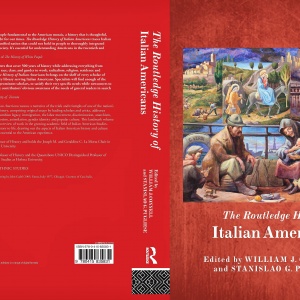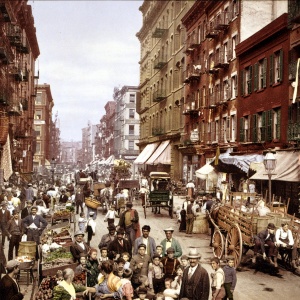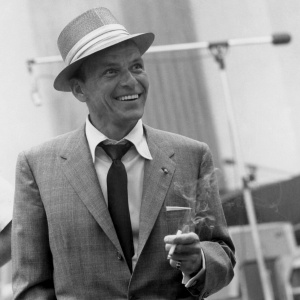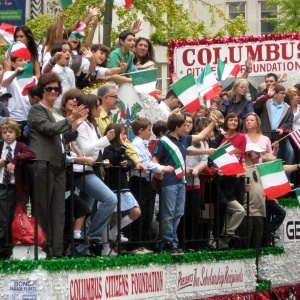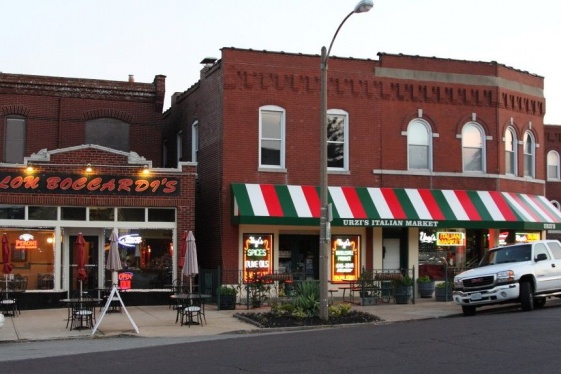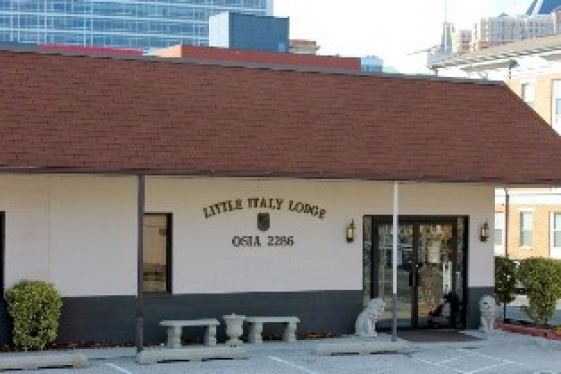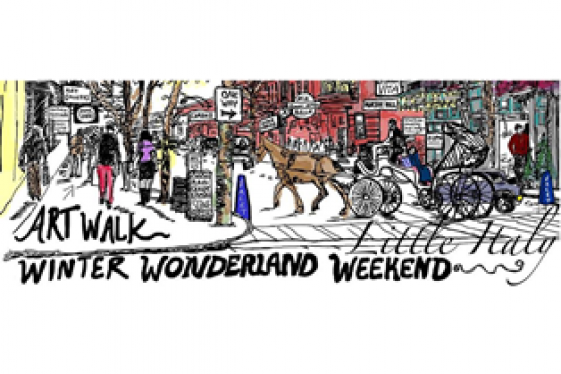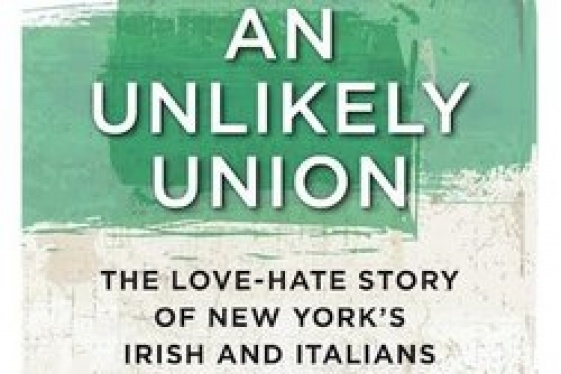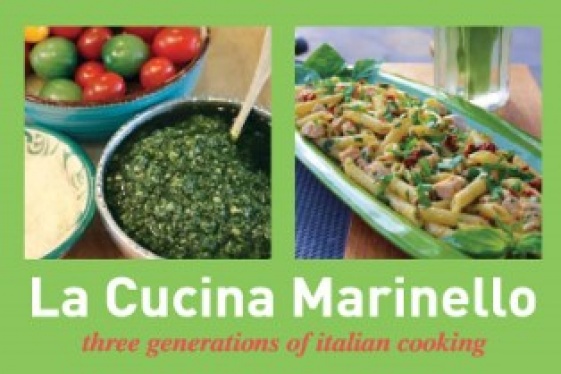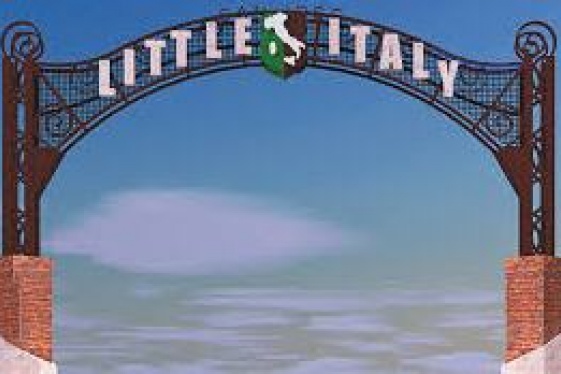
Bill Connell and Stan Pugliese (Authors of "The Routledge History of Italian Americans")
"The Routledge History of Italian Americans": una vera, eccezionale enciclopedia

There are several books that tell in many ways one or more aspects of the Italian American community; and there are some that have been entrusted with the mission of telling it in its entirety. Some of these works are excellent, but in these days a book is coming out that promises to give a never seen before picture of the Italian American experience.
It is a monumental work, created by two scholars who have been working on these themes for years, Bill Connell and Stan Pugliese. We welcome them on We the Italians, and we thank them very much for their work, that will be available here from October 3rd.
Bill, Stan, you are publishing a book of 660 pages, all about the Italian Americans and their history. I must confess it isn't easy to formulate just a few questions … you and the several authors of the book cover pretty much the whole nine yards. It's simply AMAZING. You two have done such a tremendous job, this will be an encyclopedia that will make history within the Italian American community
Stan: Well, we hope so.
Bill: Stan said some of this in his conclusion to our book: it’s like giving a history to a people, which is a very special thing. It’s not like writing the history of a war, or an election, or writing a biography, you know. Writing the history of a “people” is what Moses did, or when, after the fall of the Roman Empire, they began writing histories of the Goths, of the Vandals, of the Lombards.
Like those, this is the history of a migratory people. And it has never been done in a critical way, so as with those histories have been lots of legends, legends of origin, for instance, and these things have to be looked at critically. There was an Italian, Polydore Virgil, who wrote the first solid “ History of England,” in which he demolished legends about Britain being settled by a Roman called “Brutus.” When his book was published it upset some people who believed in these traditions so much that they accused him of burning ancient manuscripts. Like Polydore, we’re trying to offer a history based on the real lives of Italian Americans, as opposed to popular legends.
When and how did you have the idea of this encyclopedia?
Bill: I always thought there was a need, for Italian Americans of a detailed multi-authored history. Italian scholarship has created some superb multi-authored histories - the Einaudi “Storia d’Italia”, and the one produced by UTET, come to mind. The goal is to bring together authors who have different expertise and different points of view to cover a whole historical landscape. Italian Americans didn’t have that.
When UNICO National, a major Italian American charitable organization that has sponsored a number of endowed chair and institutes for Italian Studies in American universities, asked what could be done to crown their efforts, I suggested doing a book like this that would include contributions from the relevant experts. I assumed someone else would then edit it, but when they asked me to do it, I reached out to Stan, first as a friend, but also because Stan has done detailed work on later periods of this history, while I have done a lot on earlier periods, so together we made a really good team.
Stan: I think it was tremendously ambitious, but also necessary. In every class that I teach, I ask students to do hypothetical exercises, such as: “Imagine if you wake up tomorrow and you’ve forgotten everything about yourself: your name, your family, your ethnicity, your religion. Would you be the same person that you were a couple of days ago?” And they realize that no, they would not be the same person.
Then I try to get them to extrapolate from that. So, what if a whole civilization or ethnic group forgot its history, what would be the consequences of something like that? I don’t think Italian Americans were in danger of losing our history, I think we were in danger of not remembering our history with all its nuances, with all its complexity. I think the Italian American community now, after more than 100 years from its first arrival, is politically, economically, psychologically, socially in a place from where we can look back at our past with all its virtues and defects and put together something like this book.
Also, it is important because no single person could do something like this: it had to be a collective effort. So, we are extraordinarily grateful to the three dozen collaborators, our colleagues, friends and scholars from all over the world, who have really gone above and beyond. And Bill, who was the master at bringing all these people together and working with them, really has accomplished something extraordinary.
Is there a pattern you chose … a thematic one, or a geographic one, or maybe following a timeline?
Bill: Yes, there is a kind of pattern, definitely a chronological pattern although many of the chapters are thematic. There are four parts to the book. The first part is about exploration and foundation, the second is about coming to the United States and making “Little Italies,” the third part is about becoming Americans and the fourth part is about the more recent experiences of Italian Americans.
You put together so many authors, something that only people who have charisma and recognition by their peers would be able to do. Italians are not known for easily participating altogether for a common effort. How did you succeed in putting 37 incredibly talented Italian American and also Italian authors together, and come out with a coherent, well calibrated, thorough book?
Stan: I should say that as a testament to Bill’s organizational skills, I don’t think one scholar that we approached with an invitation turned us down. In fact, it was sort of like an embarrassment of riches, that we had to not invite, if that is the right word, several people that we would have liked to include. But it would have been almost impossible to include everybody. As it is, I think we did a very good job at covering a lot of ground, both material that is supposedly common knowledge and things that most Italian Americans and Americans might not know about. And I have to say that all of the contributors were really very gracious and very patient with our suggestions and with everything that we asked of them. It’s really wonderful that it turned out to be such a pleasant project to work on, even though it was an extraordinary amount of work.
Bill: One important thing to add - something long overdue, but it’s wonderful - is that now there is serious interest in Italy for the history of Italian Americans and the Italian diaspora. It’s a growing area of research within Italian academia. And we made a special effort to include some Italian authors, either by translating their work into English, or by recruiting Italians who write in English. So, there is an international aspect here that you don’t find in any of the earlier accounts of Italian Americans.
I agree with you, this book is important for Italy too. Is the book going to be published in Italian in Italy?
Bill: If there is a publisher in Italy who is interested, we will be happy to make whatever arrangements are necessary. Some of the chapters were originally written in Italian, which may make things a little easier. The book will be an ideal resource for Italian researchers interested in studying Italian Americans.
Bill, your introduction starts with this sentence: "It was in the 1980s that Italian Americans finally “made it” in American society." Please, explain us why
Bill: It’s important to realize the progress in social status that Italian Americans have made. In the 1880s and 1890s, the image of Italian Americans was very negative. We have chapters discussing the lynching of Italian Americans, the discrimination they faced, the cartoons that depicted Italians as ruffians and gangsters. There was a great sense of Italians as outsiders, as inferior.
The situation only began to change during World War II, when a great integration of Italian Americans to American society took place. After WWII the Italian presence in mainstream American culture continued to grow, thanks to singers like Frank Sinatra, thanks to the adoption of Italian dishes like spaghetti and pizza that became staples in the American diet in the 1950s. By 1963 or 1964 Italian Americans could reasonably anticipate that this role in the mainstream would continue to grow.
However, the late 1960s and 1970s were a very difficult time for Italian Americans. It was a period of leaving the cities, of what was known as white ethnic flight. There were tensions with other ethnic groups, with African Americans and Puerto Ricans. The image of the Mafia spread throughout American society in the 1970s.
So, there was a step backward, as many perceived it, and it was only in the 1980s that newspapers and magazines began to announce that Italian Americans had “made it,” or, as some historians have put it, they “became white.” So, that’s what it meant to me, to refer to “making it” in the 1980s. Of course, there’s a certain irony to this. One thinks, first, of those who haven’t “made it.” And then there are also the ways in which Italian Americans preserve a particular identity down to this day. Are they just “ordinary” Americans today? That is a question the authors of this book grapple with again and again.
Stan: If I just could add something to that. When I teach my course on Italian American history I often begin on the first day of class saying to my students: “If you were having a conversation 100 years ago in 1917 and said to someone ‘By the end of the 20th century there would be not one but two Italian Americans on the Supreme Court’ they would have thought you were crazy.”
Like Bill says, by the time you get to 1980s, we have Italian American governors, politicians, and Supreme Court justices later on. That is an important story in itself, but the flip side of that is there is a danger of forgetting a past. Sometimes you have to pay a price for becoming mainstream.
I cannot choose between the several papers in the book: all of them are beautifully written, very interesting, addressing a fundamental topic for the Italian American community. What's the most curious thing you learnt working on this?
Stan: I came to Italian American studies from Italian studies, so I had a certain perspective. I had always known about the incredible diversity of Italian American culture. Still, I think that this was really reinforced going through the essays: how the experience in New York was very different from New Orleans, how it was different in San Francisco, how there were communities in places like mining towns in Colorado, or share-cropping plantations in the American south, or cigar factories in Florida. And so, what I came away with was this renewed appreciation for the resiliency of Italian American culture and a question: what was it in Italian culture that made the possibility of success in Italian American culture? I think that it was especially the culture from the “Mezzogiorno”, the south of Italy, the civilization that my parents came from, that enabled them to cross thousands of miles of ocean in a couple of weeks and become successful in a completely different kind of culture. I think that if you look at the essays altogether, even though each one is a small jewel in itself, they gave this complex portrait of a sociological and historical, psychological transformation that is really extraordinary.
Bill: Where this was most revealing for me, and it opened up things that I hadn’t studied before, was in the accounts of the experience of Italian American women. For instance there was a great emphasis on the poverty and squalid living conditions of the Little Italies in early scholarship. But things were even worse for women back in Southern Italy and Sicily. When they got to Little Italy there was a more extended social world made newly available to them. It was liberating for these female immigrants that they had the ability to make money through weaving and embroidery. Women would socialize with one another in tenements in ways that they couldn’t do in their isolated homes in isolated rural villages back in Italy and Sicily. The special experience of Italian American women can be seen continuing in the chapters on memoirs, journals and novels that our authors Mary Jo Bona and JoAnne Ruvoli explore in their essays. This was particularly illuminating to me.
Stan, without spoiling your conclusion, please tell us why you named it "The Future of Our Past" …
Stan: The conclusion isn’t so much an attempt at a prognosis or prophecy of the future. Any depiction of the future of the Italian American community that we come up with would probably be wrong. What I am hoping to do in the conclusion is to get readers of the Italian American community to think of this book not as a culmination, but as the beginning of something: two or three generations of scholars working together, opening up new paths, new ways of thinking about the Italian American experience, whether it be gender, whether it be through cultural studies, whether it be through things like architecture, or politics.
That’s why I think it’s incumbent upon us to think about Italian American history in a different way. It was Benedetto Croce echoing Giambattista Vico, who said: “The only way you can really know something is by writing its history.” If we don’t write our own history, someone else will. This is more like a manifesto for Italian Americans to be more involved in the writing of our history, in the way we’re depicted in the media, textbooks, literature and the general culture.
Last question: what do you think about the repeated attacks towards Christopher Columbus? What the Italian American community should do?
Bill: This history does begin in 1492. It wasn’t just that Columbus, Vespucci happened to be Italian. While it is true that the early voyages into the Atlantic sailed under the flags of Atlantic nations, what’s not been sufficiently recognized is that the funding for these expeditions came from Italian venture capitalists. So, historically speaking, the discovery of the New World was an enterprise that was more broadly “Italian” than is usually recognized. As for what happened as a consequence, with respect to the Columbus Day holiday, there needs to be a recognition that this is history, that it happened a long time ago. History obviously leaves room for regret and mourning, but that doesn’t mean that the past and its legacies should be forgotten.
Recently the organizers of the Columbus Day parade in New York City consulted me on how to handle the historical questions about Columbus. I said they really should do two things. First, come out with a very strong statement acknowledging that like many people in history Columbus did some things that even back then were morally unacceptable and still are today. In fact he did some awful things as Viceroy on the island of Hispañola in 1499 and 1500 that led to his removal, and historians in recent years have continued to discover more misdeeds in documents in the archives in Spain. But what Columbus did in 1492 effectively created the world we now live in. It was a moment as important in the history of the human race and of this planet as the discovery of agriculture. That would seem reason enough to commemorate it.
My second recommendation, if this is to remain a national holiday, was to make a strong effort to include other ethnic groups, especially Native Americans. I pointed to the 1892 parade in New York, when the emphasis was on schools and public education, which was a new thing back then, and the parade included children from all the schools, all the nationalities. There was the Dante Alighieri Italian School but also the Carlisle Indian School from Pennsylvania. So you had Italian and Native American schools marching together in the Columbus Day parade.
Stan: I would just add that I think the Italian American community is or should be at a point now where we can look back at our history with a more critical eye - not that we have to criticize everything - but to understand that things are a little more complex. So, for example, leaving aside the criticism of his behavior in the New World and slavery, just take for example this Earth changing shift, which is that Columbus’ work, his exploration, basically signaled the end of the Italian city-state dominance of European culture. They went from the city-states of Genoa and Venice and Milan and others being the center of political, cultural, economic life of Europe, to the Atlantic becoming the dominant force in the world. There is a tremendous historical irony that it was an “Italian” who was responsible for the “decline” of Italy in the modern world. So, in a way, Columbus is a microcosm of the complexity of Italian American culture. Sure, we should celebrate our accomplishments in triumph, but at the same time we have to acknowledge that those very triumphs and accomplishments sometimes are a little more complicated that we think.
And what Italy should do for you? If we should do something.
Stan: As Bill mentioned, we made an effort to include younger generations of Italians scholars who were working on Italian American studies. For way too long, Italian scholars had considered Italian American culture like a backwater, something that wasn’t even worthy of their attention, refusing to realize that there are just as many Italians outside of Italy as there are living in Italy. That’s changed, and we have the scholars in our volume to prove it. As far as Columbus is concerned, I think Italy too has to bear some kind of responsibility in demonstrating Columbus’s incredible impact on the world: I mean the modern world would not exist without him, with all the kind of moral, political and ethical complexity that he embodied.
Bill: To continue Stan’s thought, there’s a maturation process that is going on among Italian Americans. As Stan says, they’ve reached a status where they can criticize themselves and also accept criticism. Now is the time for a mature recognition of the complexity of history, both by Italian Americans and also by the Italians in Italy who are now increasingly on the receiving end of the experience of mass immigration.
You may be interested
-
'Phantom Limb': A Conversation With Dennis...
Dennis Palumbo is a thriller writer and psychotherapist in private practice. He's the auth...
-
“The Hill” St. Louis’ Little Italy
When the fire hydrants begin to look like Italian flags with green, red and white stripes,...
-
1st Annual Little Italy Cannoli Tournament
Little Italy San Jose will be hosting a single elimination Cannoli tournament to coincide...
-
2015 scholarship competition
The La Famiglia Scholarship committee is pleased to announce the financial aid competition...
-
30th Annual Art Holiday Walk, Winter Winter...
Holiday walk hours Friday, 12/5 noon-9pm, Saturday ,12/6 noon-9pm Sunday, 12/7 noon-6pm. S...
-
An Unlikely Union: The love-hate story of Ne...
Award-winning author and Brooklynite Paul Moses is back with a historic yet dazzling sto...
-
Former Montclair resident turns recipes into...
Former Montclair resident Linda Carman watched her father's dream roll off the presses thi...
-
Little Italy Arch Groundbreaking Celebration
**The ceremony will be held in Little Italy SJ at W. Julian and North Almaden (Next to Pae...





